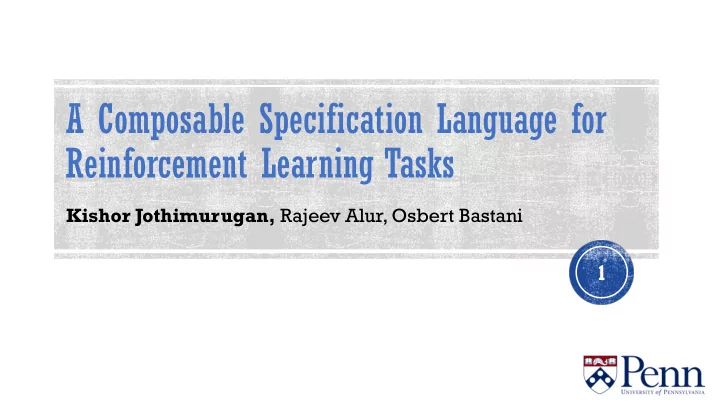

A Composable Specification Language for Reinforcement Learning Tasks Kishor Jothimurugan, Rajeev Alur, Osbert Bastani 1
Control System Ø Continuous states and actions Controller 𝑡 ∈ 𝑇 𝑏 ∈ 𝐵 Ø System can be probabilistic Ø Discrete Time System Ø Finite time horizon - T 𝑇 = Set of System States 𝐵 = Set of Control Inputs 2
Reinforcement Learning Controller Neural Network 𝑡 ∈ 𝑇 𝑏 ∈ 𝐵 Ø Use neural networks to map states to Ø Use neural networks to map states to actions actions Ø Design reward function R mapping runs to Ø Design reward function R mapping runs to System rewards rewards 𝑇 = Set of System States Ø Learn NN parameters optimizing: Ø Learn NN parameters optimizing: 𝐵 = Set of Control Inputs 3
Reward Functions Ø Too low-level as compared to logical specification Ø No obvious way to compose rewards 𝑆 ' : Reward function for “Reach q” 𝑆 ( : Reward function for “Reach p” Reward function for “Reach q and then Reach p” ? 4
Need to generate reward function from a given logical specification 5
Need For Memory Ø Specification: Reach q, then Reach p, then Reach r Ø Controller maps states to actions Ø Action at p depends on the history of the run Solution: Add additional state component to 𝑠 indicate whether q has already been visited 6
Need to generate reward function from a given logical specification Need to automatically infer the additional state components from the specification 7
Our Framework Ø System MDP = 𝑇, 𝐵, 𝑄, 𝑈, 𝑡 . where 𝑄 𝑡, 𝑏, 𝑡 / = Pr 𝑡 / 𝑡, 𝑏) given as a black-box forward simulator Ø Specification 𝜒 given in our task specification language Synthesizes a control policy 𝜌 ∗ such that, 𝜌 ∗ ∈ argmax 9 Pr[𝜍 ⊨ 𝜒] 8
Our Framework Product MDP System Reinforcement Learning Algorithm Reward Monitor Function Automaton Nondeterministic Specification Control Policy Task Monitor 9
Task Specification Language 𝜚 ≔ achieve 𝑐 𝜚 ' ensuring 𝑐 𝜚 ' ; 𝜚 ( | 𝜚 ' or 𝜚 ( Ø Example base predicates: o 𝑂𝑓𝑏𝑠 A is satisfied if and only if the distance to q is less than 1 o 𝐵𝑥𝑏𝑧 D is satisfied if and only if there is a positive distance to O Ø Specification for navigation example: achieve 𝑂𝑓𝑏𝑠 A ; achieve 𝑂𝑓𝑏𝑠 K ensuring 𝐵𝑥𝑏𝑧 D 10
Quantitative Semantics Ø Assume each base predicate 𝑐 ∈ 𝑄 is associated with a quantitative semantics, 𝑐 : 𝑇 → ℝ such that, 𝑡 ⊨ 𝑐 if and only if 𝑐 𝑡 > 0 𝑂𝑓𝑏𝑠 𝑡 = 1 − 𝑒𝑗𝑡𝑢 𝑡, 𝑟 o A 𝐵𝑥𝑏𝑧 D 𝑡 = 𝑒𝑗𝑡𝑢(𝑡, 𝑃) o Ø Extend to positive Boolean combinations by, 𝑐 ' ∨ 𝑐 ( = max( 𝑐 ' , 𝑐 ( ) o 𝑐 ' ∧ 𝑐 ( = min( 𝑐 ' , 𝑐 ( ) o 11
Task Monitor Ø Finite State Machine Ø Registers that store quantitative information Ø Compilation similar to NFA construction from regular expressions Task Monitor for 𝜚 = achieve 𝑐 12
Task Monitor Register Updates Transition Predicate Registers Task monitor for achieve 𝑂𝑓𝑏𝑠 A ; achieve 𝑂𝑓𝑏𝑠 K ensuring 𝐵𝑥𝑏𝑧 D 13 𝑣:
Extended Policy Monitor state (q) Map state q to neural network System state System action Next monitor Register values transition Neural Network for state q 14
Assigning Rewards Given a sequence of extended system states, 𝜍 = 𝑟 . , 𝑡 . , 𝑤 . → ⋯ → (𝑟 f , 𝑡 f , 𝑤 f ) what should be its reward? Ø Case 1: ( 𝑟 f is a final state) Reward is given by monitor Ø Case 2: ( 𝑟 f not a final state) Not all tasks have been completed o Suggestion 1: 𝑆(𝜍) = −∞ o Suggestion 2: Find a reward function 𝑆′ that preserves ordering of runs w.r.t. 𝑆, 𝑆 𝜍 > 𝑆 𝜍′ implies 𝑆 / 𝜍 > 𝑆′(𝜍′) 15
Reward Shaping Given 𝜍 = 𝑟 . , 𝑡 . , 𝑤 . → ⋯ → (𝑟 f , 𝑡 f , 𝑤 f ) with 𝑟 f non-final, 𝜏 ' 𝑣 ' 𝑟 f Higher reward for states farther from start 𝜏 x 𝑣 x 𝑆 // (𝑟 f ) (𝑡, 𝑤) = 𝐷 j + 2𝐷 m 𝑒 A n − 𝐸 + max ⟦𝜏 p ⟧(𝑡, 𝑤) p 𝑆 / 𝜍 = max t∶A v wA n 𝑆′′(𝑟 f )(𝑡 t , 𝑤 t ) Prefer runs that get close to satisfying some predicate on transitions that make progress 𝑒 A : Length of the longest path from 𝑟 . to 𝑟 without using self loops § 𝐷 j : Lower bound for possible reward in any final state § 𝐷 m : Upper bound on the third term for all 𝑟 § 16
Experiments Ø Implemented our approach in a tool called SPECTRL (SPECifying Tasks for RL) Ø Case study in the 2D navigation setting: o 𝑇 = ℝ ( and A = ℝ ( o Transitions given by 𝑡 tz' = 𝑡 t + 𝑏 t + 𝜁 where 𝜁 is a small gaussian noise 17
2D Navigation Tasks SPECTRL TLTL CCE 18 Learning curves for different tasks
2D Navigation Tasks Sample Complexity Curve Y-axis denotes number of sample trajectories needed to learn X-axis denotes number of nested goals 19
Cartpole Learning Curve for Cartpole Spec: Go to the right and return to start position without letting the pole fall 20
THANK YOU! 21
Recommend
More recommend